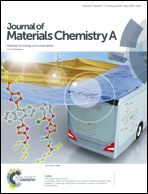Hexagonal nanoplates of high-quality γ-gallium oxide: controlled synthesis and good heterogeneous catalytic performance for thiophenes†
Abstract
Hexagonal nanoplates of high-quality γ-gallium oxide (γ-Ga2O3) were successfully synthesized by using a competitive and cooperative interaction model based on multiple equilibria, including a precipitation interaction, a coordination interaction and two binding interactions. The synthetic method is straightforward and affords the desired product in very high yield. It is important to note that only a combination of the coordination interaction and binding interactions can contribute to the formation of hexagonal nanoplates by effectively suppressing the generation of gallium oxide hydroxide and directly limiting the assembly of the nanoplates into microflowers. This model is significant because it allows us to understand how the disassembly process of nanostructures is related to the synergistic mechanism of multiple interactions. Furthermore, the γ-Ga2O3 hexagonal nanoplates exhibit good heterogeneous catalytic performance for the oxidation reaction of thiophenes. A possible mechanism was proposed for the catalytic process, and this may open up a new perspective in the study of oxidative desulfurization.



 Please wait while we load your content...
Please wait while we load your content...